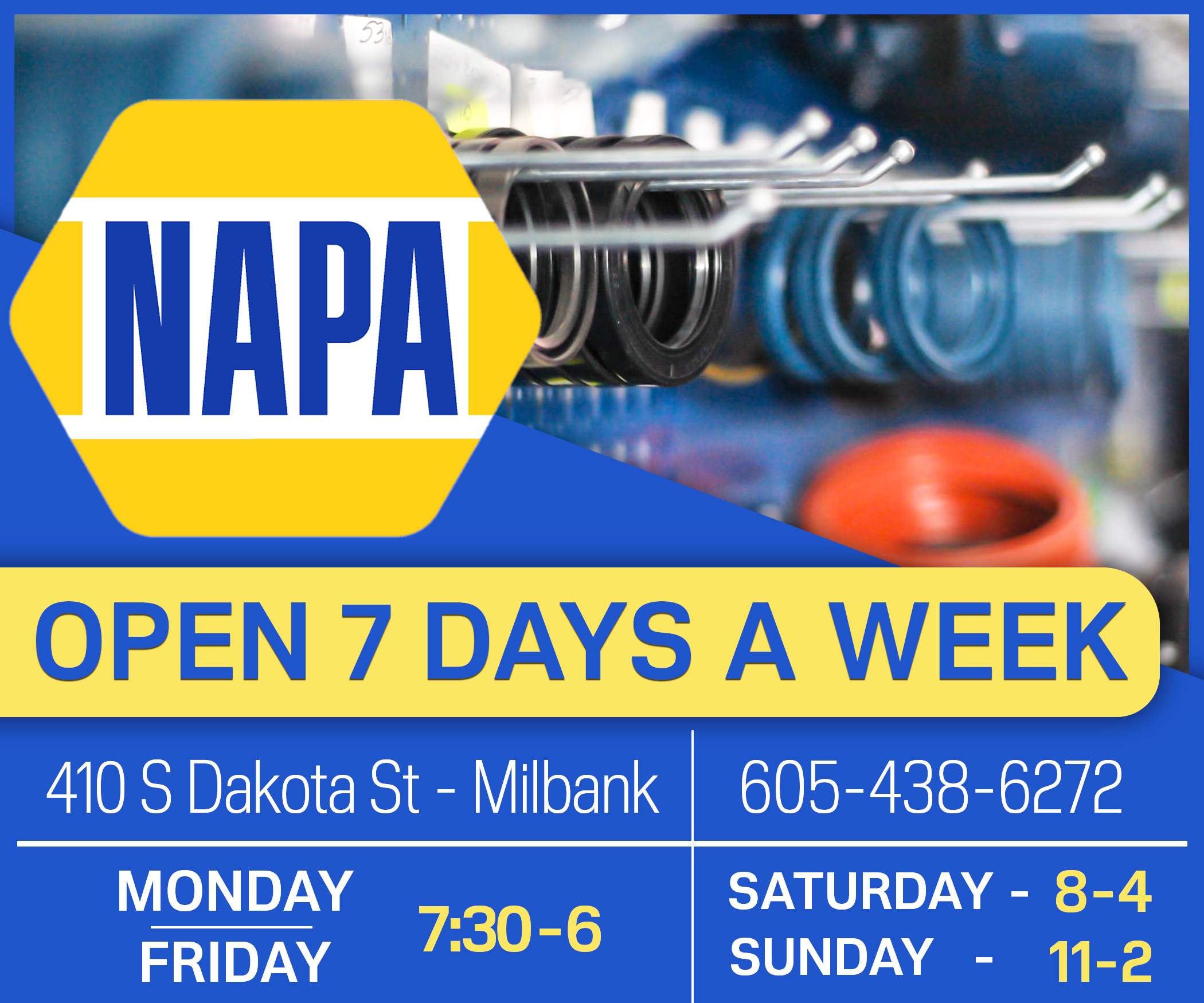Fire Chiefs Schuelke and Giesen Share Thoughts on International Firefighters Day
Local News May 4, 2022 Staff 0


Today, May 4, is International Firefighters Day. It is a day to honor every person brave enough to have ever called themselves a firefighter. As the saying goes, “All men are created equal.Then a few become firemen.”
International Firefighters Day awards special honor to firefighters who were lost in the line of duty. Since Milbank Fire and Rescue was formed in 1905 as a volunteer fire department, their team has not suffered a loss of life during a fire call.
Dale Englund of the Stockholm Volunteer Fire Department, however, made the supreme sacrifice on March 5, 1979. Also lost in the line of duty in northeast South Dakota, were Jacob and William Waldner. Their last call was on September 15, 2011, at the Sunset Colony near Britton. All three of the men’s names are engraved on the South Dakota Fallen Firefighters Memorial in Pierre, along with the names of South Dakota’s other 44 firemen who have been lost since 1924.
The Milbank Fire and Rescue Department consists of 36 volunteers. Every time the siren sounds each firefighter who responds risks life and limb to save our community.
What makes someone sign up to run into a burning building? What are the best and worst things about being a fireman? What is the biggest challenge a small-town fire department faces?
The Valley Express talked with Kevin Schuelke, who has served the Milbank Fire Department for over 35 years, many of them as the fire chief, and David Giesen, Milbank’s new fire chief, to learn the answers to these and other burning questions. One thing is certain, underneath those heavy helmets, rubber boots, and insulated gloves, Milbank firefighters’ hearts are made of gold. They deserve our thanks and support today and every day.
KEVIN SCHUELKE – Milbank Fire & Rescue for over 35 years, many of them as the fire chief
Q: Who inspired you to be a fireman?
A: Steve Durrick and Norm Giesen
Q: Who has most influenced you since you joined?
A: Ron Bjerke
Q: When did you join the Fire and Rescue team?
A: I started in 1985 on standby because the squad was too full. I stayed on standby until 1987 and then became an active member.
Q: What was your title or role then?
A: Firefighter
Q: What is your role now?
A: I was fire chief until April. Now my official title is fire administrator (chief’s right hand). I’m still an active firefighter and head of Grant County Emergency Management.
Q: When you were in grade school did you get a red fire hat from a fireman?
A: Oh, yes! The fire hats then became a thing of the past in our fire department, but when I became chief, I brought them back.
Q: Ever pretend to be a fireman when you were a child?
A: Yes. Didn’t every kid? That’s why I just had to bring the fire hats back.
Q: Did you have a favorite Superhero?
A: Nope.
Q: What did you learn in high school that you use today in your firefighting job?
A: I was a farm kid and grew up around agriculture and was in the FFA program, so I learned a lot about this area.
Q: What is the best thing about being a fireman?
A: Helping people in our area at their darkest time.
Q: What is the worst thing about being a fireman?
A: Responding to a fire in 20-below temperatures. And, always knowing the fire call could be for family and friends.
Q: How much does the gear you wear weigh?
A: I’m guessing about 150 pounds.
Q: What is the most important small firefighting tool?
A: I’d say the hose line because that follows the water.
Q: What is the most important tool the fire department has added since you joined the squad?
A: There are several things. One is the self-contained breathing apparatus. Also, when we went from steel fire equipment to aluminum. A really helpful tool we have now is a thermal-imaging camera. It gives firefighters a clear view into a dark, smoky place. We can put the images on a screen to help make more accurate decisions.
Q: In regards to fire and rescue, what keeps you awake at night?
A: Firefighters dread bad weather! Every one of us lays out our clothes when we go to bed at night. If we know there is a storm coming, we make sure our vehicle is ready to go.
Q: Do you actually get cats out of trees?
A: (Laughing) We have a couple of times. I guess it depends on what you consider an emergency.
Q: How would you describe the camaraderie of your fellow firefighters?
A: Respect. In our department, we have so much respect for each other.
Q: What is the worst fire you were called to?
A: All are bad in different ways. Any time kids and their belongings are involved that is terrible. WestCon was a pretty bad fire in 2010. We were there for days.
Q: What is your favorite food to eat after going to a fire?
A: We always get pizza at the firehall after a big fire.
Q: What is the biggest challenge of a small-town fire department?
A: Almost every town will tell you it’s recruitment and retention. Milbank has neither of those problems. I consider our volunteer fire department to be more fortunate than career fire departments. We have experts in so many fields that arrive at every scene – carpenters, body shop guys, linemen, the list goes on.
Q: What do you look for when you take on a new member of the squad?
A: Commitment. Responsibility. Good moral background. Everything is about balance.
DAVID GIESEN – Milbank Fire & Rescue’s new Fire Chief
Q: Who inspired you to be a fireman?
A: My grandpa was a fireman in Jackson, Minnesota, my uncle was the fire chief there, and my dad was a fireman in Milbank.
Q: Who has most influenced you since you joined?
A: At first, Ron Bjerke. Then, Kevin Schuelke.
Q: When did you join the Fire and Rescue team?
Q: September 1997.
Q: What was your title or role then?
A: Fireman – one of the squad.
Q: What is your role now?
A: Fire chief.
Q: When you were in grade school did you get a red fire hat from a fireman?
A: I remember going to the fire hall but not the hat.
Q: Ever pretend to be a fireman when you were a child?
A: Yes. I played with toy fire trucks.
Q: Did you have a favorite Superhero?
A: Not a fantasy superhero, but I had real life ones – police, ambulance, etc.
Q; What did you learn in high school that you use today in your firefighting job?
A: There’s one thing I really wish I had paid more attention to in high school – creative writing. I need it for my annual mailer.
Q: What is the best thing about being a fireman?
A: Helping people when they need it most.
Q: What is the worst thing about being a fireman?
A: The things you see that you can’t unsee. And, the.fear of family being at the next scene you come upon.
Q: How much does the gear you usually wear weigh?
A: Not sure, but it is heavy.
Q: What is the most important small firefighting tool?
A: Axe.
Q: What is the most important tool the fire department has added since you joined the squad?
A: We have gotten updated rescue tools with new boron steel. Before, the jaws of life wouldn’t cut very well.
Q: Do you actually get cats out of trees?
A: (Laughing) Not since I’ve been here.
Q: What is the most important thing you learned from another fireman?
A: Always have each other’s back. The first thing I learned was “two go in; two come out.”
Q: What is the No. 1 quality that makes you a good fire chief?
A: It would probably be getting along with the other guys. Someone has to be in charge, but you still need to be open to everyone and not be on a power trip.
Q: How would you describe the camaraderie of your fellow firefighters?
A: We get along like brothers. One big family. They are a good bunch of guys. There are differences of opinions, but we all get along.
Q: What is the worst fire you were called to?
A: My first fire stands out. It was at Dakota Granite. It was in the winter of 1998.
Q: What is your favorite food to eat after going to a fire?
A: You are always hungry after a fire, so you grab whatever there is. But after a bigger fire, we have pizza at the fire hall.
Q: What is the biggest challenge of a small-town fire department?
A: Most departments would say keeping an active roster and keeping guys interested. Milbank doesn’t have a big turnover. We have a good squad that’s pretty split between young and older members. I think we have about 36 guys. Luckily, we actually train more than we fight fires. I also think we have a huge advantage over a paid department because we have so many firefighters with experience from careers in different areas.
Q: What do you look for when you accept a new member of the squad?
A: Work ethic. Desire to be on the squad. You can’t force anyone to be a firefighter.












No comments so far.
Be first to leave comment below.